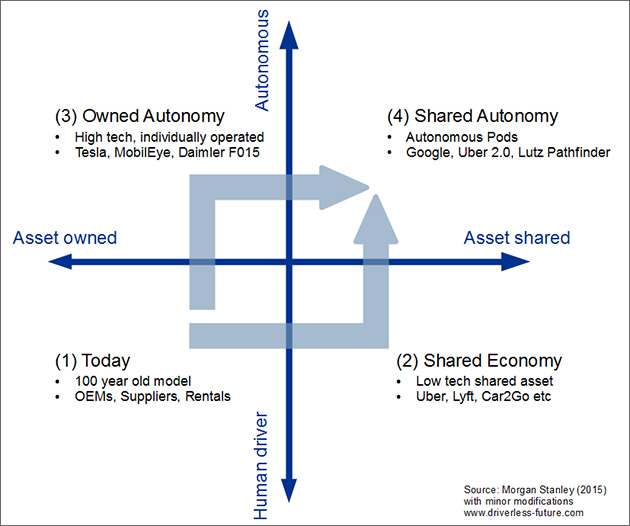-
CENTRES
Progammes & Centres
Location
 PDF Download
PDF Download 
Observer Research Foundation, with support from UBER, convened a roundtable on The Future of Urban Mobility in India in May this year in Mumbai. Participants also gathered in smaller groups to outline key concerns currently limiting urban mobility — such as supporting infrastructure, principles for regulating the ride-sharing industry, and dynamic pricing. Officials from the Maharashtra state government joined the discussions with members of civil society working at the intersection of innovation and urban mobility, business, and academia. This report is an outcome of the discussions and recommendations proposed by the participants at the roundtable. As India’s urban hubs continue to become more congested and polluted — and with increasing road fatalities and inequity in access — India will need to find a solution to fix its urban mobility crisis. Expanding public transportation services will be key to transforming mobility in India’s urban centres, along with efficient use of existing roads and smarter traffic management through technology-based interventions.

Introduction
While the majority of Indian citizens still live in rural areas, last estimated at 70 percent of the total population [i] — cities in India are also growing, with the number of inhabitants currently in the hundreds of millions. By 2030, India will see the rise of some 68 urban sprawls, each with a population of more than one million; the entire continent of Europe only has 35. [ii] It is indisputable that cities are the engines of economic growth. To realise the full potential of its economy and demography, India must not only look to increase its rate of urbanisation but also enhance the quality of life in existing cities. Today, Indian cities are characterised by increasing levels of congestion, pollution, road fatalities, and inequity in access. To build inclusive, safer, and more sustainable cities of tomorrow, technology will play a decisive role in identifying mobility gaps and transforming existing transportation services.
The discussion around urban mobility in India stands transformed today for two reasons. First, technology has enabled real-time analysis of public transportation routes and traffic patterns that was previously not possible. Second, public sector agencies have now begun to encourage the use of public transportation through new mobility business models such as on-demand and multimodal trip-planning applications. [iii] This is the reflection of a global trend where governments and businesses are exploring mobility solutions through multimodal transportation — where users will have the option of seamlessly integrating services like public transportation and ride-sharing, instead of having to choose one over the other. Integrated payment systems such as London’s Oyster [iv] and Singapore’s EZ-Link [v] allow users to opt for different modes of public transportation through a single smartcard. These solutions, however, cannot be realised through the efforts of any one entity alone. Integration will require collaborative efforts by a diverse set of stakeholders: among them, central and state governments, transit agencies, infrastructure developers, transportation service providers, and data scientists.
As companies explore different ways to provide mobility in Indian cities, through ride-sharing, bus aggregation and car rentals [vi] — stakeholders must agree on the guiding principles for regulating the on-demand and ride-sharing industry. Recognising these realities, Observer Research Foundation (ORF), with support from UBER, convened a roundtable on The Future of Urban Mobility in India in early May in Mumbai. The participants included Maharashtra government personnel, and members of civil society working at the intersection of innovation and urban mobility, business, and academia. In addition to a roundtable discussion, a workshop was organised where breakout groups outlined key concerns currently limiting urban mobility—from infrastructure deficits to the absence of clear regulatory principles for on-demand and ride-sharing applications. Following the structure of the workshop, the recommendations are divided into three sections: evaluating infrastructure and promoting innovation in mobility, regulation of the ride-sharing industry, and adoption of dynamic pricing.
1. Evaluating transportation infrastructure and promoting innovation in urban mobility
The roundtable participants agreed that deficiencies in supporting infrastructure would need to be addressed before adopting new technologies in urban mobility such as driverless or electric cars. The transportation infrastructure in India—consisting of roads, suburban railways, metro lines and fuel stations—is inadequate in supporting current needs or any future rise in population. Poor transportation infrastructure development may be attributed to lack of political will, skills, and coordination amongst public agencies both at the state and city level. For example, there is insufficient route allocation for public transportation, leading to over-crowding in some routes and deficit in others. Experts have earlier noted other reasons for delay in development of infrastructure, including failure in devising and applying common design standards during construction and high costs and time-consuming processes involved in land acquisition. [vii]
Further, the absence of reliable travel data, until now, has made it difficult for public officials to assess the impact of infrastructure projects on urban mobility and to identify future needs. This is no longer the case with developments in geo-mapping technologies and open standards, with GTFS (General Transit Feed Specification) being the most commonly used. Transit agencies need to make GTFS feeds on routes and schedules and GIS locations on transport infrastructure publicly available. Some transit agencies have also released data sets on budgetary, performance and ridership data. [viii] Government officials and businesses can make pointed investments in supporting infrastructure by analysing historical data on roadways and transportation. This data can be useful for policymakers, transit agencies, and urban planners to enable infrastructure to facilitate better mobility through efficient use of existing roads and smarter traffic management. Moreover, open transport data in other countries has led to the development of third-party mobile applications sharing real-time transit information, which enables users to plan their trips better, leading in turn to increased ridership and improved customer experience. [ix] Indeed, studies have shown that open data in transportation presents huge economic opportunities—valued at between US$720 and US$920 billion globally—as it results in innovation in multi-modal planning apps and new mobility businesses. [x]

Specific Recommendations
Principles for governing the ride-sharing industry in India
Participants in ORF’s roundtable agreed that regulations governing the ride-sharing industry must promote user safety and competition in the market. However, regulation should not dictate business models and must be non-prescriptive or ‘light touch’. After all, the transport department is usually an incumbent in the market and must not play the role of a regulator.
To guide regulation, principles based on fairness, equity and safety must first be established with the purpose of incentivising new and smaller players in the market. Regulation — or the lack of it — plays an important role in promoting innovation. This, when companies are trying to push the government to legalise new mobility models such as using private cars for ride-sharing [xi] — with some state governments contemplating banning ride-sharing altogether. [xii] However, regulators have the additional burden of protecting user safety and would be cautious before adopting new business models. As drivers of traditional taxi services [xiii] and ride-sharing companies [xiv] demand government intervention to safeguard their interests, to prevent falling incomes and changing incentive structures [xv] — companies must be transparent in their policies and directly address issues involving their drivers. Companies must share with regulators their data on pricing mechanisms and user behavior, such as user demand and willingness to pay, to help promote evidence-based policymaking.
In Maharashtra, the enforcement of the City Taxi Rules, 2017 [xvi] might have an adverse effect on competition as it imposes a significant license fee on driver-partners seeking to operate through ride-sharing applications. Ride-sharing companies should be allowed to regulate themselves and the point of entry for public regulation must only lie in safeguarding consumer safety and competition in the market. The licensing authority must not prescribe either a price floor or cap on surge pricing, and regulators must instead consult with the Competition Commission of India (CCI) before regulating pricing.
Specific Recommendations

III. Adopting dynamic pricing to meet urban mobility challenges
Ride-sharing companies price their fares dynamically based on variables including estimated time and distance of the predicted route, estimated traffic, and the number of riders and drivers using the service at a given moment. [xvii] During high demand for rides, prices peaks to reflect the ‘surge’ in demand to ensure that pickups are available for riders who are willing to pay the increased fare. UBER has attracted criticism for inflating prices after terrorist attacks, [xviii] during natural disasters [xix] and even while Delhi implemented its odd-even scheme in early 2016. [xx] In the aftermath of the London Bridge attack in June this year, UBER suspended their surge pricing after some delay [xxi] and refunded those users who were charged an increased fare [xxii] — a practice the company has followed earlier during terror incidents. [xxiii] State governments including Delhi, [xxiv] Karnataka [xxv] and most recently, Maharashtra, [xxvi] have clamped down on taxi aggregators charging surge pricing by introducing caps on fares. Governments introduce caps on surge pricing to safeguard consumer interests and prevent predatory pricing.
Surge or dynamic pricing helps in increasing vehicle utilisation and reliability, and dynamic pricing based on demand and supply of drivers on a real-time basis ensures access to mobility. However, during emergencies such as natural disasters and terrorist attacks, surge pricing must be suspended. [xxvii] The dynamic pricing model must also be imported to parking spaces to deter driving and to encourage public transportation. Dynamic pricing in the ride-sharing industry has been successful in influencing user behaviour in India. In the future, policymakers must consider dynamic pricing mechanisms based on variables such as road congestion, fuel efficiency, and carbon emissions. [xxviii]
Specific Recommendations
India’s urban mobility challenge will only become more acute in the coming decade as cities become more crowded, polluted and unsafe. Any mobility crisis is a unique one, seeing as it involves a multitude of actors from transit agencies to ICT entrepreneurs. To meet the challenge effectively, a dialogue between stakeholders is essential to evaluate assets and to devise innovative mobility solutions. To encourage new businesses that leverage technology to provide mobility, policymakers must first agree on principles for regulation based on fairness, safety and equity. New mobility is a lucrative industry — one that can serve local communities and provide opportunities to many. As the Maharashtra government looks to make sustainable urban transport a priority, Mumbai can become a model for policymakers and entrepreneurs in India to use ICT to provide customised, safe and sustainable transportation to all. [xxix]
Endnotes
[i] “About 70 per cent Indians live in rural areas: Census report”, The Hindu, July 15, 2011, http://www.thehindu.com/news/national/About-70-per-cent-Indians-live-in-rural-areas-Census-report/article13744351.ece
[ii] “India’s urban awakening”, McKinsey & Company”, April, 2010, . http://www.mckinsey.com/~/media/mckinsey/global%20themes/urbanization/urban%20
awakening%20in%20india/mgi_indias_urban_awakening_full_report.ashx
[iii] Kailash Korde, “Mumbai’s kaali-peelis to launch their own mobile app to race ahead of Uber and Ola”, Hindustan Times, May 2, 2017, , http://www.hindustantimes.com/mumbai-news/mumbai-s-kaali-peelis-launch-their-own-mobile-app-to-race-ahead-of-uber-and-ola/story-oJm6iro9PnCKDEAMdJKcjP.html
[iv] Oyster Cards, Transport for London, https://oyster.tfl.gov.uk/oyster/entry.do
[vi] Rahul Sachitanand, “How new startups like LiftO, Shuttl, rBus are trying to solve urban commuting problem”, The Economic Times, accessed June 9, 2017,
[vii] “Urban Transport in India”, Indian Institute for Human Settlements, accessed July, 2015, http://iihs.co.in/knowledge-gateway/wp-content/uploads/2015/07/RF-Working-Paper-Transport_edited_09062015_Final_reduced-size.pdf
[viii] See for example the MBTA (Massachusetts Bay Transportation Authority) dashboard where data on reliability, ridership, financials and customer satisfaction have been made public.
[ix] Sarah M. Kaufman , “Getting Started with Open Data” , NYU Wagner, May, 2012,, https://wagner.nyu.edu/files/rudincenter/opendata.pdf
[x] Zainab Kakal, Roshan Toshniwal, “Why India needs open data for better urban mobility”, The City Fix, February 19, 2015, http://thecityfix.com/blog/india-needs-open-data-better-urban-mobility-zainab-kakal-roshan-toshniwal/ , “Open data: Unlocking innovation and performance with liquid information”, McKinsey Global Institute, October, 2013, 2017,http://www.mckinsey.com/~/media/McKinsey/Business%20Functions/McKinsey%20
Digital/Our%20Insights/Open%20data%20Unlocking%20innovation%20and%20performance
%20with%20liquid%20information/MGI_Open_data_Executive_summary_Oct_2013.ashx
[xi] Sayan Chakraborty, Mihir Dalal, “Uber lobbying with govt to allow ride sharing using private cars in India”, Livemint, March 7, 2017, http://www.livemint.com/Companies/ZWMN3J1xSTNAlTkOKooSkJ/Uber-lobbying-with-govt-to-allow-ride-sharing-using-private.html
[xii] Sunny Sen, “Is it end of road for ride-sharing by Uber and Ola, over safety, legality debate?”, Hindustan Times, , February 7,2017, http://www.hindustantimes.com/business-news/is-it-end-of-road-for-ride-sharing-by-uber-and-ola-over-safety-legality-concerns/story-QRq21sDNNkEYm7HcA31W7I.html
[xiii] Sweta Goswami, “Ola-Uber strike back in Delhi on Tuesday: Brace for high fares, long wait”, Hindustan Times, April 17 , 2017, http://www.hindustantimes.com/delhi-news/ola-uber-protest-strike-back-on-tuesday-brace-for-higher-cab-fares-longer-wait/story-gUYGNT79cJKk3zyYLtfpZP.html
[xiv] Sweta Goswami , Heena Kausar,“Delhi Ola, Uber strike enters Day 8: Few cabs plying but commuter woes continue”, Hindustan Times, February 17 , 2017, http://www.hindustantimes.com/delhi-news/delhi-ola-uber-strike-enters-day-8-few-cabs-plying-but-commuters-woe-continue/story-cVMlk4UoM49uYt6nnU9ORN.html
[xv] Anurag Mazumdar,“Why the Problems of Uber, Ola Drivers Are Far From Over”, The Wire, accessed June 9, 2017, https://thewire.in/113979/ola-uber-driver-problem-far/
[xvi] Kailash Korde, “Surge pricing: Here’s how Maharashtra will regulate Ola and Uber cabs”, Hindustan Times, March 5 , 2017, http://www.hindustantimes.com/mumbai-news/maharashtra-finally-has-rules-to-regulate-ola-and-uber-cabs/story-ztQncRSwGzq088I180wXyH.html, Maharashtra City Taxi Rules, 2017,
https://transport.maharashtra.gov.in/Site/Upload/Pdf/mahacts17%20.pdf?MenuID=1227
[xvii] UBER’s fares are priced according to above the mentioned variables – https://help.uber.com/h/34212e8b-d69a-4d8a-a923-095d3075b487
[xviii] Charles Riley,“Uber criticized for surge pricing after London terror attack”, CNN,June 5, 2017, http://money.cnn.com/2017/06/04/technology/uber-london-attack-surge-pricing/index.html
[xix] Victor Luckerson , “Uber Agrees to Limit Surge Pricing During Emergencies, Disasters”, Time, accessed July 8 , 2017, http://time.com/2967490/uber-agrees-to-limit-surge-pricing-during-emergencies-disasters/
[xx] Pritha Chatterjee , Sarah Hafeez, |“ Odd-Even phase II: Uber, Ola withdraw surge price after govt warns of strong measures”, The Indian Express, April 6, 2016, http://indianexpress.com/article/cities/delhi/arvind-kejriwal-uber-surge-pricing-delhi-odd-even-ola-app-based-taxis/
[xxi] Josie Cox,“London terror attack: Uber slammed for being slow to turn off ‘surge pricing’ after rampage”, Independent, June 4, 2017, http://www.independent.co.uk/news/uk/home-news/london-terror-attack-uber-criticised-surge-pricing-after-london-bridge-black-cab-a7772246.html
[xxii] Holly Christodoulou ,“FARE PLAY Uber to refund those who fled London Bridge attack after being criticised for activating surge prices”, The Sun, accessed June 5, 2017, https://www.thesun.co.uk/news/3728351/london-bridge-attack-uber-refund-price-surge/
[xxiii] Harry Readhead, “Brussels attacks: Uber turns off surge pricing in Belgian capital”, Metro, March 22, 2016, , http://metro.co.uk/2016/03/22/brussels-attacks-uber-turns-off-surge-pricing-in-belgian-capital-5768254/
[xxiv] “Delhi government acted against 8,000 cabs for surge pricing”, The Indian Express, accessed June 9, 2017, http://indianexpress.com/article/cities/delhi/delhi-cabs-surge-pricing-ola-and-uber-cabs-4424144/
[xxv] Umesh Yadhav, Mugdha Variyar, “Uber ordered to limit surge pricing, comply with Karnataka rules for taxi aggregators”, The Economic Times, November 11 , 2016, http://economictimes.indiatimes.com/small-biz/startups/uber-ordered-to-limit-surge-pricing-comply-with-karnataka-rules-for-taxi-aggregators/articleshow/55364437.cms
[xxvi] Kailash Korde, “Surge pricing: Here’s how Maharashtra will regulate Ola and Uber cabs”, Hindustan Times, March 5,, 2017, http://www.hindustantimes.com/mumbai-news/maharashtra-finally-has-rules-to-regulate-ola-and-uber-cabs/story-ztQncRSwGzq088I180wXyH.html
[xxvii] “Digital-Age Transportation:
The Future of Urban Mobility”, Deloitte University Press, July , 2014, https://www2.deloitte.com/content/dam/Deloitte/tr/Documents/public-sector/EN_Digital-Age-TRANSPORTATION_16.07.2014.pdf
[xxviii]Id.
[xxix] Somit Sen, Sujit Mahamulkar “Maharashtra govt policy proposes costlier vehicles, high parking fees”, The Times of India, June 7, 2017, http://timesofindia.indiatimes.com/city/mumbai/state-draft-proposes-costlier-vehicles-high-parking-fees/articleshow/59042684.cms
The views expressed above belong to the author(s). ORF research and analyses now available on Telegram! Click here to access our curated content — blogs, longforms and interviews.

Madhulika Srikumar was a 2019 India-U.S. Fellow at New America. Srikumar worked on India-U.S. data sharing for law enforcement and explored the underlying privacy standards ...
Read More +